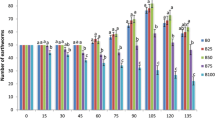Abstract
The purpose of this study is to evaluate the effect of different animal dung in vermicompost production using Eudrilus eugeniae worm and spent mushroom substrate (SMS) as a vermicomposting medium. The experiment was carried out for 40 days in completely randomized design (CRD) on four replicates for each treatment. The treatments were T1 (6 SMS + 3 cow dung + 1 chopped banana trunk (CB)), T2 (6 SMS + 3 goat dung + 1 CB), T3 (6 SMS + 3 chicken dung + 1 CB) and T4-Control (6 SMS + 0 animal dung + 1 CB). Data on pH, EC, vermicompost biodegradability coefficient, worm population and reproductive rate were observed. Results showed that the pH of vermicompost after vermicomposting ranges from 7.34 to 6.82 and the EC value was decreased ranging from 32 to 88%. The vermicompost biodegradability coefficient was greater in T4 (0.82), followed by T1 (0.37), T2 (0.36) and T3 (0.13). The population of the worm was higher in T4 (178.75 worms) as compared to T2 (153.75 worms), T1 (153.25 worms) and T3 (10 worms). Results revealed that chicken dung is not a suitable medium to be used as part of a mixture in the vermicomposting medium since it has prevented the reproduction of E. eugeniae worms. Meanwhile, medium with or without cow dung can be used for vermicompost production since the growth rate and the number of the worm were greater in both mediums.
Access this chapter
Tax calculation will be finalised at checkout
Purchases are for personal use only
Similar content being viewed by others
References
Diaz LF, Savage GM, Eggerth LL, Golueke CG (1996) Solid waste management for economically developing countries. ISWA, Vienna
Eklind Y, Kirchmann H (2000) Composting and storage of organic household waste with different litter amendments. II: nitrogen turnover and losses. Bioresour Technol 74(2):125–133
Gómez-Brandón M, Lazcano C, Domínguez J (2008) The evaluation of stability and maturity during the composting of cattle manure. Chemosphere 70(3):436–444
Garg VK, Chand S, Chhillar A, Yadav A (2005) Growth and reproduction of Eisenia foetida in various animal wastes during vermicomposting. Appl Ecol Environ Res 3(2):51–59. https://doi.org/10.15666/aeer/0302_051059
Graff O (1982) Vergleich der Regenwurmarten Eisenia foetida und Eudrilus eugeniae hinsichtlich ihrer Eignung zur Proteingewinnung aus Abfallstoffen. Pedobiologia
Garg P, Gupta A, Satya S (2006) Vermicomposting of different types of waste using Eisenia foetida: a comparative study. Biores Technol 97(3):391–395
Li Q, Deng M, Coombes AJ (2017) Evaluation of spent mushroom compost as a container medium for production of seedlings of two oak species. Nat Environ Pollut Technol 16(2):529–534
Lim SL, Wu TY (2016) Characterization of matured vermicompost derived from valorization of palm oil mill byproduct. J Agric Food Chem 64(8):1761–1769
Lin C (2008) A negative-pressure aeration system for composting food wastes. Biores Technol 99(16):7651–7656
Manyuchi MM, Phiri A, Muredzi P, Chitambwe T (2013) Comparison of vermicompost and vermiwash bio-fertilizers from vermicomposting waste corn pulp
Ministry of Agriculture (MOA) (2012) Dasar Agromakanan Negara (DAN). Jabatan Penerbitan, Malaysia
MOA (2010) Dasar Agromakanan Negara 2011–2020. Kementerian Pertanian Malaysia dan Industri Asas Tani, Malaysia
Nath G, Singh K, Singh DK (2009) Chemical analysis of vermicomposts/vermiwash of different combinations of animal, agro and kitchen wastes. Aust J Basic Appl Sci 3(4):3672–3676
Ndegwa PM, Thompson SA, Das KC (2000) Effects of stocking density and feeding rate on vermicomposting of biosolids. Biores Technol 71(1):5–12
Rasib NAA, Zakaria Z, Tompang MF, Rahman RA, Othman H (2015) Characterization of biochemical composition for different types of spent mushroom substrate in Malaysia. Malays J Anal Sci 19(1):41–45
Sabrina DT, Hanafi MM, Mahmud TMM, Azwady AN (2009) Vermicomposting of oil palm empty fruit bunch and its potential in supplying of nutrients for crop growth. Compos Sci Util 17(1):61–67
Sharma K, Garg VK (2018) Comparative analysis of vermicompost quality produced from rice straw and paper waste employing earthworm Eisenia fetida (Sav.). Biores Technol 250:708–715
Singh D, Suthar S (2012) Vermicomposting of herbal pharmaceutical industry waste: earthworm growth, plant-available nutrient and microbial quality of end materials. Biores Technol 112:179–185
Singh RP, Embrandiri A, Ibrahim MH, Esa N (2011) Management of biomass residues generated from palm oil mill: vermicomposting a sustainable option. Resour Conserv Recycl 55(4):423–434
Viljoen SA, Reinecke AJ (1989) Life-cycle of the African nightcrawler, Eudrilus eugeniae (Oligochaeta). Afr Zool 24(1):27–32
Williams BC, McMullan JT, McCahey S (2001) An initial assessment of spent mushroom compost as a potential energy feedstock. Biores Technol 79:227–230
Yadav A, Garg VK (2011) Vermicomposting–an effective tool for the management of invasive weed Parthenium hysterophorus. Biores Technol 102(10):5891–5895
Author information
Authors and Affiliations
Corresponding author
Editor information
Editors and Affiliations
Rights and permissions
Copyright information
© 2020 Springer Nature Singapore Pte Ltd.
About this paper
Cite this paper
Ahmad, N., Sukri, N.M., Samsuddin, N.Z. (2020). The Effect of Different Animal Dung in Vermicompost Production Using Eudrilus eugeniae Worm and Spent Mushroom Substrate as Vermicomposting Medium. In: Alias, N., Yusof, R. (eds) Charting the Sustainable Future of ASEAN in Science and Technology . Springer, Singapore. https://doi.org/10.1007/978-981-15-3434-8_12
Download citation
DOI: https://doi.org/10.1007/978-981-15-3434-8_12
Published:
Publisher Name: Springer, Singapore
Print ISBN: 978-981-15-3433-1
Online ISBN: 978-981-15-3434-8
eBook Packages: Social SciencesSocial Sciences (R0)




